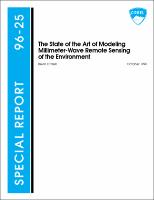Please use this identifier to cite or link to this item:
https://hdl.handle.net/11681/12200Full metadata record
| DC Field | Value | Language |
|---|---|---|
| dc.contributor.author | O'Neill, Kevin, 1946- | - |
| dc.date.accessioned | 2016-06-20T14:30:30Z | - |
| dc.date.available | 2016-06-20T14:30:30Z | - |
| dc.date.issued | 1996-10 | - |
| dc.identifier.uri | http://hdl.handle.net/11681/12200 | - |
| dc.description | Special Report | - |
| dc.description | Abstract: A survey was undertaken of models for millimeter-wave (MMW) scattering and emission from environmental features, particularly in the vicinities of 35 and 94 GHz. The ultimate objective was to identify models suitable for current or near-future application in scene generation. The ideal model would be based on first principles, would be readily available in facilitated software, and would have reasonable requirements in terms of computational resources and input parameters. At MMW frequencies, these requirements push the frontiers of current science and technology. In most applications, one must accept as a first approximation the approaches currently under development in research settings. This report reviews the basic methods and approaches underlying all available models in terms of volume scattering, treatment of surfaces and transitions, and the development of statistical quantities from rational physics. Very rough surfaces, locally steep surface slopes, and low-angle incidence can rarely be treated entirely successfully, but recent developments offer the prospect of significant progress. Volume and combined surface–volume scattering and emission models are reviewed for application to land, water, vegetation, snow, and ice environments. Most are essentially works in progress, with theory and validation currently building from earlier work at C and X bands. Very sound capabilities are available for treatment of common atmospheric features, with recent progress in modeling more complex meteorological events. Limiting consideration to truly available codes, a list is provided for each of the above areas of models and their sources. Because it is the most comprehensive and is currently facilitated in terms of software, the MIT EMSARS model is the foremost condidate to serve as a platform for future addition and development. | - |
| dc.publisher | Cold Regions Research and Engineering Laboratory (U.S.) | - |
| dc.publisher | Engineer Research and Development Center (U.S.) | - |
| dc.relation | http://acwc.sdp.sirsi.net/client/en_US/search/asset/1001441 | - |
| dc.relation.ispartofseries | Special report (Cold Regions Research and Engineering Laboratory (U.S.)) ; 96-25. | - |
| dc.rights | Approved for public release; distribution is unlimited. | - |
| dc.source | This Digital Resource was created in Microsoft Word and Adobe Acrobat | - |
| dc.subject | Algorithms | - |
| dc.subject | Mathematical models | - |
| dc.subject | Modeling | - |
| dc.subject | Surface scattering | - |
| dc.subject | Emission | - |
| dc.subject | Remote sensing | - |
| dc.subject | Volume scattering | - |
| dc.subject | Millimeter-wave (MMW) | - |
| dc.subject | Software | - |
| dc.subject | Microwave remote sensing | - |
| dc.subject | Smart weapons | - |
| dc.title | The state of the art of modeling millimeter-wave remote sensing of the environment | - |
| dc.type | Report | en_US |
| Appears in Collections: | Special Report | |
Files in This Item:
| File | Description | Size | Format | |
|---|---|---|---|---|
| SR-96-25.pdf | 383.38 kB | Adobe PDF |  View/Open |